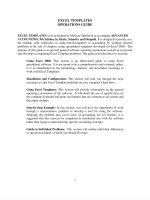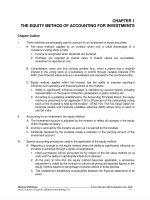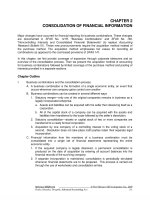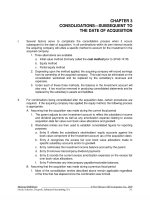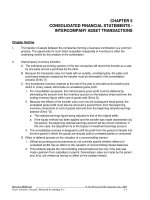Solution manual advanced accounting 2nd by hamlen CH09
Bạn đang xem bản rút gọn của tài liệu. Xem và tải ngay bản đầy đủ của tài liệu tại đây (674.06 KB, 28 trang )
Find more at www.downloadslide.com
CHAPTER 9
SOLUTIONS TO MULTIPLE CHOICE QUESTIONS, EXERCISES AND PROBLEMS
MULTIPLE CHOICE QUESTIONS
1.
a
$905,000 = $1,000,000 – ($1,340,000 – $1,245,000)
2.
d
$90,000 = $1,400,000 – $1,310,000; asset because prices declined on a short position.
3.
c
Sales revenue
Cost of sales $1,000,000 – ($1,340,000 - $1,200,000)
Gross margin
4.
$1,290,000
860,000
$ 430,000
b
Call options lock in the future purchase price; they cannot hedge inventory already
purchased. Put options hedge existing inventories by locking in their selling price.
5.
a
(.05 - .047) x ½ x $4,000,000 = $6,000
6.
c
Interest expense reduces by $6,000 (gain) but the cap increases in value by $5,000.
Therefore the time value change is a $1,000 loss. The entry is:
Loss on cap
Investment in cap
Interest expense
7.
1,000
5,000
6,000
d
$1,000 = (4.0% - 3.8%)/2 x $1,000,000 net cash received to settle the swap.
Solutions Manual, Chapter 9
©Cambridge Business Publishers, 2013
1
Find more at www.downloadslide.com
8.
b
A receive fixed/pay variable swap is a fair value hedge of the fixed rate debt. Both the
debt and the swap are marked to market, with value changes reported in income.
Because interest rates declined, the fair value of the debt increased, creating a loss.
9.
a
A receive fixed/pay variable swap is a fair value hedge of the fixed rate debt. Both the
debt and the swap are marked to market, with value changes reported in income.
Because interest rates declined, Sunny pays the lower variable rate and the fair value of
the swap increased, creating a gain.
10.
c
A receive variable/pay fixed swap is a cash flow hedge of the variable rate interest
payments. The swap is marked to market, with value changes reported in OCI. The debt
is not revalued. Because interest rates declined, the present value of the fixed payment
obligation increased, creating a loss. The loss will be reclassified to income in the next
period, adding to the lower variable interest recorded on the variable rate debt.
©Cambridge Business Publishers, 2013
2
Advanced Accounting, 2nd Edition
Find more at www.downloadslide.com
EXERCISES
E9.1
Fair Value Hedge: Short in Commodity Futures
a.
January 6, 2013
Investment in futures
10,000
Cash
To record the initial margin deposit on the sale of commodity futures.
February 19, 2013
Loss on hedging
10,000
11,000
Cash
11,000
To pay additional cash to the broker to cover the loss of $11,000 (= $171,000 - $160,000)
realized on the decline in value of the futures contracts.
Inventory
11,000
Gain on hedging
11,000
To adjust the carrying value of the hedged inventory for the change in fair value.
Cash
10,000
Investment in futures
10,000
To record receipt of $10,000 from the broker, the initial deposit which is returned after
the futures are closed.
March 2, 2013
Cash (or accounts receivable)
173,500
Sales
173,500
To record sale of commodities.
Cost of goods sold
Inventory
To charge the inventory sold to cost of sales.
b.
161,000
161,000
If AIPC had not hedged by selling futures short, it would have avoided the $11,000 loss
sustained when the short futures sold for $160,000 were closed by purchasing an
offsetting long contract for $171,000. AIPC’s profit, which was $12,500 (= $173,500 $161,000) under the hedge, would therefore have increased by $11,000 to $23,500 (=
$173,500 - $150,000 inventory acquisition cost) if the hedge was not undertaken.
Solutions Manual, Chapter 9
©Cambridge Business Publishers, 2013
3
Find more at www.downloadslide.com
E9.2
Fair Value Hedge: Long in Commodity Futures
a.
June 1, 2014
Investment in futures
10,000
Cash
To record the initial margin deposit on the purchase of commodity futures.
10,000
The long position in the futures contract hedges an existing liability, the deferred
revenue, and serves as a fair value hedge. A value change of $10,000 [= ($11 - $10) x
10,000] is realized on June 30, representing a gain on the futures contracts and a loss on
the exposed liability.
June 30, 2014
Investment in futures
10,000
Gain on hedging
10,000
To record the $10,000 gain on the long position hedging deferred revenue, an existing
liability.
Loss on hedging
10,000
Deferred revenue
10,000
To record in earnings the increase in the fair value of the commodities needed to settle
the liability.
A further value change of $5,000 [= ($11.50 - $11) x 10,000] is realized on August 29,
which also is a gain on the futures contracts and a loss on the exposed liability.
August 29, 2014
Investment in futures
5,000
Gain on hedging
5,000
To record the $5,000 gain on the long position hedging deferred revenue, an existing
liability.
Loss on hedging
5,000
Deferred revenue
5,000
To record in earnings the increase in the fair value of the commodities needed to settle
the liability.
Cash
25,000
Investment in futures
25,000
To record receipt of the margin deposit from the broker, increased by the gains on the
futures contracts; $25,000 = $10,000 + $10,000 + $5,000.
When the commodities are shipped to the customer, the deferred revenue, which now
includes the total $15,000 value change (loss), will be recognized as realized revenue.
©Cambridge Business Publishers, 2013
4
Advanced Accounting, 2nd Edition
Find more at www.downloadslide.com
b.
E9.3
Even though Daley intends to purchase the commodity in the spot market, the purchase
of futures locks in the ultimate price paid at $10.00. Daley received $150,000 from the
customer; without hedging, any increase in the spot price reduces Daley's ultimate profit
on the transaction. With hedging, if the commodity's price increases, the gain on the long
futures position offsets the loss created by having to purchase the commodity at that
higher price.
Without hedging:
Cost of commodity at spot price ($11.50 x 10,000)
$115,000
With hedging:
Spot price paid ($11.50 x 10,000)
Realized gain on futures contract [($11.50 - $10.00) x 10,000]
Net cost of commodity
Amount saved by hedging
$115,000
(15,000)
$100,000
$ 15,000
Hedge of Firm Commitment: Short in Commodity Futures
The short position in the futures contract hedges a firm sale commitment and is a fair value
hedge.
May 1, 2014
Investment in futures
10,000
Cash
To record the initial margin deposit of $10,000 paid to the clearinghouse.
May 30, 2014
Investment in futures
10,000
20,000
Gain on hedging
To mark the short futures position to market and recognize the gain in earnings;
$20,000 [= ($5.00 - $4.80) x 100,000].
20,000
Loss on hedging
20,000
Firm commitment
20,000
To recognize the loss on the firm sale commitment due to a decline in selling prices.
Solutions Manual, Chapter 9
©Cambridge Business Publishers, 2013
5
Find more at www.downloadslide.com
July 29, 2014
Investment in futures
5,000
Gain on hedging
To mark the short futures position to market and recognize the resulting gain;
$5,000 [= ($4.80 - $4.75) x 100,000].
5,000
Loss on hedging
5,000
Firm commitment
5,000
To recognize the loss on the firm sale commitment due to a decline in selling prices.
Commodities inventory
460,000
Cash
To record purchase of the commodities.
August 28, 2014
Loss on hedging
460,000
2,000
Investment in futures
To mark the futures contract to market; $2,000 [= $4.77 - $4.75) x 100,000].
2,000
Gain on hedging
To recognize the gain on the firm sale commitment due to a price increase.
2,000
Firm commitment
Cash
2,000
33,000
Investment in futures
33,000
To close out the short futures position and recover from the clearinghouse the initial margin
deposit; $33,000 (= $10,000 + $20,000 + $5,000 - $2,000).
When the sale occurs, the firm commitment liability is closed to Sales Revenue, increasing it by
$23,000.
©Cambridge Business Publishers, 2013
6
Advanced Accounting, 2nd Edition
Find more at www.downloadslide.com
E9.4
Economics of Hedging with Futures; Propriety of Hedge Accounting
a.
If McVeigh purchases the commodity for $4 per unit and closes out its long futures
position for $4 per unit, McVeigh incurs a cash loss of $1.50 (= $5.50 - $4) on each
futures contract. Added to the per-unit commodity cost of $4, the $1.50 loss increases the
cost per unit to $5.50.
Similarly, if McVeigh purchases the commodity for $6 per unit and closes out its long
futures position for $6 per unit, McVeigh realizes a cash gain of $.50 (= $6 - $5.50) per
futures contract. Subtracting this $.50 gain from the unit cost of $6 leaves the net cost of
the commodity at $5.50 per unit.
b.
In this case, McVeigh grows the commodity on its own farms, and may cover its delivery
commitment with its own inventory. However, GAAP requires only that the futures be
designated as a hedge of the sale commitment. The existing inventory is irrelevant.
E9.5
Interest Rate Cap
July 2, 2013
Investment in interest rate cap
9,000
Cash
To record premium paid on 4.1% interest rate cap payable in full immediately;
$9,000 = $3,000,000 x 0.0015 x 2.
December 31, 2013
Interest expense
60,000
Interest payable
To record interest payable on the loan for the first six months;
$60,000 = $3,000,000 x .04 x .5.
Loss on options
9,000
60,000
2,000
Investment in interest rate
cap
2,000
To recognize the decline in fair value of the time value portion of the premium;
$2,000 = $9,000 - $7,000. The cap remains out of the money and still has no intrinsic value.
June 30, 2014
Interest expense
Interest payable
To record interest payable on the loan for the next six months;
$64,500 = $3,000,000 x .043 x .5.
Solutions Manual, Chapter 9
64,500
64,500
©Cambridge Business Publishers, 2013
7
Find more at www.downloadslide.com
Investment in interest rate cap
3,000
Interest expense
Loss on options
3,000
2,000
Investment in interest rate
cap
2,000
To record the net $1,000 increase (= $8,000 - $7,000) in fair value of the interest rate cap.
The cap goes in the money by $3,000 [= $3,000,000 x (.043 - .041) x .5], which reduces interest
expense to $61,500 (= .5 x .041 x $3,000,000 = $64,500 - $3,000). At the same time the cap
loses $2,000 of its time value; $2,000 = $1,000 - $3,000.
Cash
3,000
Investment in interest rate
cap
3,000
To record collection of the excess interest due under the interest rate cap agreement.
E9.6
Fair Value Hedge with Put Options
March 1, 2014
Investment in options
6,200
Cash
To record purchase of put options; $6,200 = 2,000 x $3.10.
June 30, 2014
Loss on hedging
6,200
3,600
Investment in options
To record the loss on options hedging an investment in government bonds;
($3,600) = 2,000 x ($1.30 - $3.10).
Investment in bonds
3,600
4,000
Gain on hedging
4,000
To adjust carrying value of the bond investment; $4,000 = (1.00 - 0.98) x $200,000.
December 31, 2014
Investment in options
6,000
Gain on hedging
To record the gain on options; $6,000 = 2,000 x ($4.30 - $1.30).
Loss on hedging
6,000
6,000
Investment in bonds
6,000
To adjust the investment in bonds to its current fair value; $6,000 = (.97 - 1.00) x $200,000.
©Cambridge Business Publishers, 2013
8
Advanced Accounting, 2nd Edition
Find more at www.downloadslide.com
Cash
8,600
Investment in options
8,600
To record the sale of put options; $8,600 = 2,000 x $4.30 = $6,200 - $3,600 + $6,000.
Alternate entry to record sale of options:
Cash
8,600
Investment in options
2,600
Gain on hedging
6,000
To record sale of put options; carrying amount prior to revaluation at December 31, 2014 is
$2,600 (= $6,200 - $3,600).
E9.7
Call Options Hedging Foreign Currency Debt
July 1, 2012
Investment in options
28,000
Cash
To record purchase of call options; $28,000 = 2,000,000 x $.014.
December 31, 2012
Investment in options
28,000
110,000
Gain on hedging
110,000
To record gain on foreign currency call options hedging £2,000,000 note payable;
$110,000 = ($.069 - .014) x 2,000,000.
Loss on hedging
100,000
Loan payable
To accrue loss on loan payable; $100,000 = ($1.55 - $1.50) x 2,000,000.
June 30, 2013
Investment in options
100,000
102,000
Gain on hedging
102,000
To record gain on foreign currency call options hedging ,2,000,000 note payable;
$102,000 = ($.12 - $.069) x 2,000,000.
Loss on hedging
120,000
Loan payable
To accrue loss on loan payable; $120,000 = ($1.61 - $1.55) x 2,000,000.
Cash
120,000
240,000
Investment in options
240,000
To record the sale of put options; $240,000 = 2,000,000 x $.12 = $28,000 + $110,000 + $102,000.
Solutions Manual, Chapter 9
©Cambridge Business Publishers, 2013
9
Find more at www.downloadslide.com
Alternate entry to record sale of options:
Cash
240,000
Investment in options
138,000
Gain on hedging
102,000
To record sale of put options; carrying amount prior to revaluation at June 30, 2013 is
$138,000 = $28,000 + $110,000.
E9.8
Interest Rate Swap: Profit and Default
a.
Intermediary’s Inflows and Outflows:
Inflows: floating rate from Queen
fixed rate from Prince
Total inflows
Outflows: fixed rate to Queen
floating rate to Prince
Total outflows
Net interest rate spread
LIBOR + 30
T + 40
T + 30
LIBOR + 20
3.6%
3.4%
7.0%
3.3%
3.5%
6.8%
0.2%
With a .2% net spread, Intermediary was earning $2,000 (= .002 x $1,000,000) a year or
approximately $167 a month.
b.
Intermediary receives T + 40 from Prince, the equivalent of 3.4% when T = 3%, while it
is paying LIBOR + 20, the equivalent of 3.5% when LIBOR = 3.3%. Thus the money
Intermediary was making was derived from its arrangements with Queen, not Prince.
When LIBOR increases by 20 bp, the floating rate rises to 3.7% (= LIBOR of 3.3% +
0.2% + 0.2%) and Intermediary's loss on the arrangement with Prince increases to 0.3%
(= 3.7% - 3.4%). After Queen's default, Intermediary is losing $3,000 a year or $250 a
month; $250 = (.003 x 1,000,000)/12.
E9.9
Interest Rate Swap: Journal Entries
This is a plain vanilla swap. Queen has a fair value hedge because it receives fixed from the
bank and pays variable to Intermediary. In contrast, Prince has a cash flow hedge because it
receives variable from the bank and pays fixed to Intermediary.
September 30, 2014
Queen Corp.
Interest expense
750
Cash
750
To record net cash payment made to Intermediary; ($750) = [(.033 - .036) x $1,000,000]/4.
©Cambridge Business Publishers, 2013
10
Advanced Accounting, 2nd Edition
Find more at www.downloadslide.com
Loss on hedging
75,000
Investment in swaps (or swap
liability)
75,000
To mark to market interest rate swap serving as a fair value hedge; unrealized loss affects
earnings.
Prince, Inc.
Cash
250
Interest expense
250
To record net cash received from Intermediary; $250 = [(.035 - .034) x $1,000,000]/4.
Investment in swaps
33,000
OCI
33,000
To mark to market interest rate swap serving as a cash flow hedge; unrealized gain entered in
OCI.
E9.10 Interest Rate Swap
a.
January 1, 2013
Cash
10,000,000
Note payable
10,000,000
To record issue of a note payable for cash. (The interest rate swap has no value at
inception.)
June 30, 2013
Interest expense
200,000
Cash
To record interest for the first six months; $200,000 = .04 x $10,000,000/2.
Cash
200,000
35,000
Interest expense
35,000
To record net cash payment from counterparty to swap; $35,000 = (.04 - .033) x
$10,000,000/2; .033 = .027 (average LIBOR) + 60 bp.
Investment in swaps
275,000
Gain on hedging
275,000
To record the change in fair value of the swap as an asset (decline in market interest rate
increases the present value of the 4% fixed payments received from counterparty.
Loss on hedging
Note payable
To mark the hedged debt to market.
Solutions Manual, Chapter 9
275,000
275,000
©Cambridge Business Publishers, 2013
11
Find more at www.downloadslide.com
b.
The swap in a. is a fair value hedge (receive fixed/pay variable) and value changes are
reported in earnings. In b., however, Marshall is hedging the variable interest payments
on its variable rate debt and has a cash flow hedge (receive variable/pay fixed). Value
changes in cash flow hedges are reported in OCI. Because the present value of
Marshall’s fixed payment obligation rises when interest rates fall, Marshall’s new swap
becomes a liability, not an asset.
E9.11 Interpreting Interest Rate Swap Disclosures
a.
There may be no generally accepted approach to evaluating the relative favorableness of a
publicly reported swap position. The analysis below compares the relative average net pay
rates and receive rates.
In 2010, General Mills swapped fixed rate payments of 4.8% for variable rate payments of
0.3%. It swapped variable rate payments of 0.3% for fixed rate payments of 7.3%. Its
receive fixed/pay variable swaps were very profitable, and its receive variable/pay fixed
swaps resulted in losses. In a period of steeply falling interest rates, swapping fixed for
variable payments paid off.
In 2011, General Mills did not enter any receive variable/pay fixed swaps, probably due to
declining interest rates. General Mills profited by holding its variable rate debt and paying
lower interest rates. It continued to profit from converting its fixed rate debt to floating
payments, benefitting from lower variable rates.
The pay floating (receive fixed) are the fair value hedges and the pay fixed (receive floating)
are the cash flow hedges.
b.
Technically, the gains and losses on the receive fixed/pay variable swaps and the hedged
fixed-rate debt, and the related hedge ineffectiveness amount to a ―net gain/loss from
hedging.‖ Because the amounts are so small, and they relate to interest, treating them as part
of ―net interest,‖ and not reporting them separately, is not likely to do any harm.
c.
These unrealized losses resulted from swapping fixed for variable interest payments during
periods of falling interest rates. These losses will ultimately be reclassified as an increase to
interest expense that offsets the (lower) future variable rate interest. For example, assuming
a straight-line pattern, if the hedged variable rate debt has ten years to go, each year we
would see:
Interest expense
2,940,000
Accumulated other comprehensive income
2,940,000
©Cambridge Business Publishers, 2013
12
Advanced Accounting, 2nd Edition
Find more at www.downloadslide.com
E9.12 Futures and Options as Hedging Alternatives
a.
Hedging with futures and options provides the same loss-neutralization capability, as long as
similar contracts are available for the needed commodity. The principal difference between
futures and options is that options are one-sided, in that they remove the chance of loss while
retaining the chance of gain. The user pays a premium for this package. In contrast, futures
contracts are two-sided and, by requiring performance whether prices increase or decrease,
negate both the chance of loss and the chance of gain. The user pays no premium for a
futures contract but typically makes a margin deposit with the clearinghouse.
Thus, even though Sami is hedging an exposure, the option contract contains a speculative
component whereas the futures contract is a pure hedge. Whether Sami uses futures or
options depends on the firm’s tolerance for risk. Futures contracts remove the risk at very
low (transaction) cost whereas options are more like lottery tickets or gambles in which you
pay (the premium) for a chance at a gain, which could be large.
b.
Hedging with futures (fair value hedge)
Investment in futures
20,000
Cash
20,000
To record payment of margin deposit.
Loss on hedging
2,000
Cash
2,000
To record loss from decline in value of futures contracts; $2,000 = ($690 – $710) x 100.
Firm commitment asset
2,000
Gain on hedging
2,000
To record gain from reduced cost to fulfill firm commitment and related commitment
asset.
Cash
20,000
Investment in futures
20,000
To record receipt of the margin deposit when the futures contract is closed. (The long
contract was revalued to $690 and is settled by entering an offsetting short contract at
$690).
Purchases (inventory)
68,200
Cash
To record purchase of the commodity; $68,200 = 100 x $682.
Purchases (inventory)
2,000
Firm commitment asset
To close the firm commitment asset to the purchase transaction.
Solutions Manual, Chapter 9
68,200
2,000
©Cambridge Business Publishers, 2013
13
Find more at www.downloadslide.com
c.
Hedging with options (cash flow hedge)
Investment in options
5,000
Cash
To record purchase of call options; $5,000 = 100 x $50.
5,000
Loss on options
5,000
Investment in options
5,000
To record expiration of the options (they remained out of the money) and the $5,000
speculative loss. (Had the entire premium been designated as the hedge, including the $5,000
time value, $5,000 would still be written off as hedge ineffectiveness.)
Purchases (inventory)
68,200
Cash
To record purchase of the commodity; $68,200 = 100 x $682.
68,200
d.
Commodity cost with futures hedge ($68,200 + $2,000 loss on futures)
Commodity cost without hedging
Cash loss from hedging as opposed to not hedging with futures
$ 70,200
(68,200)
$ 2,000
The futures contracts locked in the $710 price and lost $2,000 when the futures price
dropped to $690. This offset the $2,000 economic gain produced by the lower purchase
price. The basis narrowed to $8 (= $690 – $682) from $10 (= $710 – $700).
Commodity cost with options hedge ($68,200 + $5,000 option premium)
Commodity cost without hedging
Cash loss from hedging as opposed to not hedging with options
$ 73,200
(68,200)
$ 5,000
The option, a kind of insurance, expired without being used. Thus its cost—the premium—
expires as well.
©Cambridge Business Publishers, 2013
14
Advanced Accounting, 2nd Edition
Find more at www.downloadslide.com
PROBLEMS
P9.1
Commodity Futures
a.
August 1, 2014
Investment in futures
75,000
Cash
To record the initial margin deposit of $75,000 paid to the broker.
September 30, 2014
Loss on hedging
75,000
40,000
Cash (or Investment in futures)
To record the loss on the futures contract; $40,000 = 10,000 x ($367 - $363).
40,000
Inventory (soybean meal)
40,000
Gain on hedging
40,000
To recognize the value change in the inventory; $40,000 = 10,000 x ($354 - $350).
October 28, 2014
Investment in futures
60,000
Gain on hedging
60,000
To record the gain on the short futures position caused by the decline in the futures price;
$60,000 = ($361 - $367) x 10,000.
Loss on hedging
60,000
Inventory (soybean meal)
60,000
To recognize the value change in the inventory; $60,000 = 10,000 x ($348 - $354).
Cash
135,000
Investment in futures
To record closing the short position and settling with the broker;
$135,000 = $75,000 + $60,000.
Solutions Manual, Chapter 9
135,000
©Cambridge Business Publishers, 2013
15
Find more at www.downloadslide.com
b.
When Davis sells the soybean meal in the spot market, it realizes a gain of $105,000 {=
[$348.50 - ($340 + $4 - $6)] x 10,000}, analyzed as follows.
Gain on sale, ignoring the hedge [10,000 x ($348.50 - $340)]
Net gain on the hedge [10,000 x ($6 - $4)]
Net gain
OR
Gain on sale assuming delivery pursuant to futures contract [($363 $340) x 10,000]
Gain on futures contract [($163 - $161) x 10,000]
Loss resulting from decision to sell on the spot market instead of
delivering under the futures contract [($363.00 - $348.50) x 10,000]
Net gain
c.
$ 85,000
20,000
$105,000
$230,000
20,000
(145,000)
$105,000
Had Davis purchased (rather than sold) the futures for $363, later closing out this
position by selling futures for $361, a $20,000 [= ($361 - $363) x 10,000] net cash loss is
sustained.
Because Davis already owns the soybean meal inventory, and does not have a firm
commitment to fulfill, purchase of soybean meal futures is either speculative or, if the
futures purchase is hedging an anticipated transaction, a cash flow hedge. The
accounting treatments of the short gain and the long loss are described next.
Short Gain: Because the sale of futures qualifies as a fair value hedge in this problem,
the net $20,000 short gain in a. enters earnings but is offset by the value change in the
hedged inventory.
Long Loss: If the purchase of futures is speculative, the $20,000 net loss on the futures is
recognized in earnings when realized. But if the futures purchase qualifies as a cash flow
hedge, the $20,000 net loss is first accumulated in OCI and later released to earnings
when the hedged anticipated transaction impacts earnings.
©Cambridge Business Publishers, 2013
16
Advanced Accounting, 2nd Edition
Find more at www.downloadslide.com
P9.2
Interest Rate Futures
a.
The long position in Treasury bill futures hedges the anticipated roll-over of Greenstein's
short-term Treasury bill investments, serving as a cash flow hedge. On June 30,
Greenstein realizes a $2,500 gain, entering it in OCI pending completion of the roll-over.
A further $1,250 gain, realized on August 30, enters OCI. The $3,750 total is
reclassified from OCI to earnings over time after the new bills are purchased. It has the
same effect as a discount that reduces the cost of the new Treasury bills and is
subsequently amortized to income as part of interest revenue.
June 1
Investment in futures
10,000
Cash
To record the initial $10,000 margin deposit paid to the broker.
June 30
Investment in futures
10,000
2,500
Other comprehensive income
To mark the Treasury bill futures to market and enter the resulting gain in OCI;
$2,500 = (.97 - .96) x ($1,000,000/4).
August 30
Investment in futures
2,500
1,250
Other comprehensive income
To mark the Treasury bill futures to market and enter the resulting gain in OCI;
$1,250 = (.975 - .97) x ($1,000,000/4).
Cash
Investment in treasury bills
(new)
1,250
6,250*
993,750
Investment in treasury bills
(old)
To record the roll-over of the investment in the Treasury bills.
1,000,000
*Cash received from redemption of old securities
Cost of new securities: $1,000,000 -[$1,000,000 x (.025/4)]
Net cash received
$1,000,000
(993,750)
$
6,250
Cash
13,750
Investment in futures
13,750
To record receipt of the margin deposit from the broker; $13,750 = $10,000 + $2,500 +
$1,250.
As interest revenue on the new Treasury bills is recorded, it is augmented by a pro-rata
share of the $3,750 gain released from OCI.
Solutions Manual, Chapter 9
©Cambridge Business Publishers, 2013
17
Find more at www.downloadslide.com
b.
The cost of the new Treasury bills is $993,750, which reflects the current 2.5% annual
discount yield (0.625% quarterly).
However, the $3,750 gain on the futures contracts currently in other comprehensive
income will increase interest income by $3,750 over the 91-day term of the new Treasury
bills. Thus the total return on the new Treasury bills is $10,000 (= $6,250 + $3,750),
which reflects a 4% annual discount yield (1% quarterly); $10,000 = .01 x $1,000,000.
P9.3
Interest Rate Futures: Fair Value Hedge
a.
At 90, each $1,000 bond has a value of $900 and futures contracts for 1,000 bonds [=
(300,000 x $3)/900)] would be sold to protect the value of Petren's own bonds that
ultimately will be sold to pay for the fabric. The face value of these bonds is $1,000,000
(= 1,000 x $1,000). This sale of futures at 90 produces a realized loss of ($20,000) [=
(.90 - .92) x $1,000,000] when the futures contract is closed out (by purchasing futures at
92). The $20,000 loss offsets the $20,000 [= (.92 - .90) x $1,000,000] realized gain on
Petren's bonds due to their increase in value before being sold to pay for the fabric.
Petren could report both the $20,000 gain and offsetting $20,000 loss but will likely net
them out. Thus the net result of this hedge is no gain or loss and no effect on earnings.
NOTES TO INSTRUCTOR:
(1)
Some students may believe that OCI should come into play here. Whereas
unrealized value changes in available-for-sale (AFS) securities are normally
accumulated in OCI, when AFS securities are hedged by a derivative, hedge
accounting requires that the AFS value change be reported in earnings to offset
the derivative’s value change. A careful reading of a. indicates that the value
changes are realized. The value changes in b., though, are unrealized.
(2)
Some students interpret this as a cash flow hedge of the anticipated sale of the
bonds, and raise the prospect of OCI in this context. However, the intent in this
problem is for the futures to hedge the fair value of the bonds held, not the
forecasted sale of the bonds.
©Cambridge Business Publishers, 2013
18
Advanced Accounting, 2nd Edition
Find more at www.downloadslide.com
b.
At any intervening balance sheet date, the futures are revalued to fair value along with
the AFS bonds, the hedged item. An unrealized loss is recognized on the short futures as
it now costs 91.5 to enter an offsetting long contract to settle the short contract sold at 90.
This loss is offset by an unrealized gain on the bonds which increased in value from 90
to 91.5. Both loss and gain are recognized in earnings.
Loss on hedging
15,000
Investment in futures
To record unrealized loss on futures serving as a fair value hedge;
($15,000) = (.90 - .915) x $1,000,000.
Investment in AFS bonds
15,000
15,000
Gain on hedging
To record unrealized gain on AFS bonds; $15,000 = (.915 - .90) x $1,000,000.
15,000
c.
To hedge the value of its AFS bonds, Petren has to sell Treasury bond futures. If Petren
buys Treasury bond futures, it no longer has an exposure to hedge and now has a
speculative futures investment. Thus the purchase of futures described in the problem
does not qualify as a hedge.
d.
Here futures are purchased at 90. If sold at 93, the futures produce a realized gain of
$30,000 [= (.93 -.90) x $1,000,000]. The bonds sold from Petren's own portfolio also
produce a gain of $30,000 for a total gain of $60,000 that is recognized in current
earnings.
P9.4
Evaluating Hedging with Futures Contracts
a.
Advantages of hedging with futures contracts include:
fixing the sale price of the commodity at the futures price ($4.75 in this case)
when the contract is entered.
eliminating the possibility of loss.
Disadvantages of hedging with futures contracts include:
tying up capital ($200,000 in this case) in a non-interest bearing margin deposit.
eliminating the possibility of gain.
b.
If the commodities are hedged with futures contracts, 1,000,000 bushels will be worth
$4,750,000 when harvested in six months. However, interest of $4,000 (= .5 x .04 x
200,000) on the margin deposit is foregone. Thus in six months the net proceeds from, or
value of, the commodities is $4,746,000 (= $4,750,000 - $4,000), implying that $4.746
per bushel is the price at which the company is indifferent. At a spot price below $4.746,
hedging dominates not hedging. If the price exceeds $4.746, not hedging dominates.
Solutions Manual, Chapter 9
©Cambridge Business Publishers, 2013
19
Find more at www.downloadslide.com
c.
Financial Statement Effects Dr. (Cr.)
(1)
(2)
Hedge with
No Hedge
Futures Contracts
Cash
$
4,000
(1) $ (500,000)
Inventory
(2) 5,250,000
(2) 5,250,000
Gain on growing crops
(5,250,000)
(5,250,000)
Loss on futures contracts
Interest income
0
(4,000)
(1)
500,000
0
(3)=(1)-(2)
Difference
$ 504,000
0
0
(500,000)
(4,000)
(1) Reflects $500,000 [= (4.75 - 5.25) x 1,000,000] loss on futures contracts.
(2) Carried at market; $5.25 x 1,000,000.
P9.5
Evaluating Hedging with Option Contracts
a.
Advantages of hedging with option contracts include:
eliminating the possibility of loss—a decline in the commodity's price will, in the
case of put options, be offset by a gain on the option.
not negating any gain created by an increase in the commodity's price.
The principal disadvantage of hedging with option contracts is paying the nonrefundable
premium ($350,000 in this case).
b.
If the commodities are hedged with option contracts and the options are exercised or in
the money at expiration, 1,000,000 bushels will be worth a net of $4,650,000 [= ($5 x
1,000,000) - $350,000]. Thus at a $4.65 spot price the company is indifferent. For spot
prices below $4.65, hedging dominates not hedging. For spot prices above $4.65, not
hedging dominates hedging.
Lost interest is ignored in the options case because the $350,000 cash paid for the options
is gone permanently; $350,000 is the present value of interest and principal repayment
foregone. In the futures case, the margin deposit caused temporary nonuse of the cash—
the cash received when the margin deposit is returned has a lower present value than the
cash originally deposited. The lost interest approximates this reduction in present value.
©Cambridge Business Publishers, 2013
20
Advanced Accounting, 2nd Edition
Find more at www.downloadslide.com
c.
Financial Statement Differences [Dr (Cr)]
(1)
(2)
Hedge with
No Hedge
Option Contracts
Cash
$
0
(1) $ (100,000)
Inventory
(2) 4,750,000
(2)
4,750,000
Gain on growing crops
(4,750,000)
(4,750,000)
Net loss on options
$
0
(1) $ 100,000
(3)=(1)-(2)
Difference
$ 100,000
0
0
$(100,000)
(1) ($100,000) = $250,000 [= ($5.00 - $4.75) x 1,000,000] cash gain on puts - $350,000
premium.
(2) Carried at market; $4.75 x 1,000,000.
P9.6
Currency Options: Short Answer Questions
a.
The strategy of purchasing call options on pounds will see the option premium rise as the
dollar cost of pounds increases. Footlocker’s exposed liability—the dollar cost of
supplying pounds—rises as the rising dollar cost of pounds rises. This exposure can be
hedged by purchasing call options to buy pounds for dollars, although the time value
component of the premium will be a loss.
Another way of getting the British pounds needed is to sell dollars for pounds. Here our
stock of dollars, an asset, represents the exposure. A decline in the pound price of dollars
occurs when the dollar depreciates and can be hedged by purchasing put options to sell
dollars for pounds. A decline in the pound price of dollars is equivalent to the rising
dollar cost of pounds as expressed above. Again the time value component of the
premium will be a loss.
Because there is no reason to believe that the premiums on puts and calls will be
identical, the economic effects of the two approaches will differ.
b.
The strategy of buying calls on pounds produces gains when the dollar cost of pounds
rises and writing puts on pounds with the same exercise price produces losses when the
dollar cost of pounds falls. This combination creates what is called a synthetic long
futures contract that hedges the exposure of purchasing pounds with dollars. The net
premium paid for the calls (received for the puts) is the cost (benefit) from adopting this
strategy instead of just buying futures.
c.
Despite the way the problem is worded, KBR, Inc.’s exposure is denominated in euros
and the hedge works by purchasing call options to buy euros. Then if the dollar cost of
euros rises, the calls go in the money and the gain on them offsets the loss on the
exposure, creating an effective hedge.
Solutions Manual, Chapter 9
©Cambridge Business Publishers, 2013
21
Find more at www.downloadslide.com
d.
Citibank seeks to protect the dollar equivalent of the euro-denominated interest it will be
receiving. If the bank writes calls for the purchase of euros with dollars and the dollar
strengthens (the € weakens), the calls stay out of the money and expire unexercised. If
the dollar weakens, the gain on the euro-denominated interest will be offset by the loss
on the written calls. Here Citibank is a ―covered call writer‖—covered by the eurodenominated interest receivable—and the premium received increases the bank's net
return.
Total premium received = .1111 x $800,000 = $88,880
If the dollar strengthens (and the euro weakens) by 7%, the dollar equivalent of the euro
interest falls by $56,000 (= .07 x €800,000). Because the $88,880 premium exceeds the
$56,000 exchange loss, writing the calls will increase Citibank’s return.
e.
By not hedging, IBM loses $.02 (= $1.45 - $1.43) per euro. With the calls, the $.02 gain
on each call negates the $.02 transaction loss on the interest. However, the $.03125
premium paid is all time value which, assuming the calls expire when the interest is due,
is a loss that increases IBM's financing cost by more than the $.02 loss from not hedging.
In total:
Cost of calls = $.03125 x 70,000 = $2,188
Loss on increased dollar value of interest due to stronger euro incurred without the hedge
= $.02 x 70,000 = $1,400
IBM is therefore $788 better off had the hedging not taken place and the hedge increased
IBM’s financing cost.
P9.7
Present Value Analysis of Interest Rate Cap and Journal Entries
a.
This is a capital budgeting problem in which the $400,000 outlay for the cap is compared
with the present value of the interest savings under the assumed prime rates. Savings
begin on July 1, 2014 [$100,000 = (.06 - .05) x $10,000,000] and increase in each of the
two years beginning on July 1, 2015 to $300,000 [= (.08 - .05) x $10,000,000]. These
savings are realized at the end of each fiscal year when the interest is due and the bank
settles up.
PV of savings = $100,000/(1.06)2 + $300,000/(1.08)3 + $300,000/(1.08)4
= $89,000 + $238,150 + $220,509
= $547,659
Since $547,659 > $400,000, purchase of the cap is a good economic decision if the prime
rate increases as expected.
©Cambridge Business Publishers, 2013
22
Advanced Accounting, 2nd Edition
Find more at www.downloadslide.com
b.
A similar approach is used here except that savings are based on comparing the new
lower 2% prime rate with the original 4% [$200,000 = (.04 - .02) x 10,000,000].
PV of savings = $200,000/(1.02)2 + $200,000/(1.02)3 + $200,000/(1.02)4
= $192,234 + $188,464 + $184,769
= $565,467
Since $565,467 > $400,000, the projected interest savings more than offset the cost of the
cap. Given the assumptions in a. and b., the cap hedges the potential loss from higher
interest rates and the potential savings from lower interest rates hedge the cost of the cap.
c.
December 31, 2014
Interest expense
300,000
Interest payable
To record interest on the loan accrued since 6/30/14; $300,000 = (.06 x
$10,000,000)/2.
Investment in interest rate cap
50,000
Interest expense
To record the gain on the cap and reduce interest expense accordingly;
$50,000 = [(.06 - .05) x 10,000,000]/2.
Loss on options
300,000
50,000
50,000
Investment in interest rate cap
50,000
To recognize the decline in fair value of the total $400,000 time value premium for four
years at the rate of $50,000 (1/8) per six-month period.
June 30, 2015
Interest expense
300,000
Interest payable
To record interest on the loan accrued since 12/31/14.
Interest payable
300,000
600,000
Cash
To pay interest accrued since 6/30/14.
600,000
Investment in interest rate cap
50,000
Interest expense
To reduce the gain on the cap and reduce interest expense accordingly.
Solutions Manual, Chapter 9
50,000
©Cambridge Business Publishers, 2013
23
Find more at www.downloadslide.com
Cash
100,000
Investment in interest rate cap
100,000
To record collection of one year's excess interest due under the interest rate cap.
Loss on options
50,000
Investment in interest rate cap
50,000
To recognize the decline in fair value of the total $400,000 time value premium for four
years at the rate of $50,000 (1/8) per six-month period.
P9.8
Fair Value Hedge: Put Options
a.
November 1, 2013
Other comprehensive income
20,000
Short-term investments
20,000
To revalue the short-term investments to market value; the decline in value from $40 to
$38 per share enters OCI income because the investments are unhedged during this
period.
Investment in options
35,000
Cash
To record purchase of 10,000 put options.
35,000
Because the strike price is $40 and the shares are selling for $38, each put option is in the
money by $2, a total of $20,000 (= 10,000 x $2). The time value is therefore $15,000 (=
$35,000 - $20,000).
December 31, 2013
Investment in options
25,000
Gain on hedging
25,000
To mark the intrinsic value of the options to market; $25,000 = 10,000 x ($38 - $35.50).
Loss on hedging
25,000
Short-term investments
To mark the hedged securities to market.
Loss on options
25,000
10,000
Investment in options
10,000
To recognize assumed 2/3 (= 60/90) reduction in fair value of the original $15,000 time
value.
©Cambridge Business Publishers, 2013
24
Advanced Accounting, 2nd Edition
Find more at www.downloadslide.com
b.
Proceeds from sale of securities (10,000 x $32)
Proceeds from sale of put options [10,000 x ($40 - $32)]
Total proceeds
Cost of securities
Cost of put options
Total cost
Net cash loss
c.
$320,000
80,000
400,000
400,000
35,000
435,000
$(35,000)
2013: The intrinsic value of the put options serves as a hedge of AFS securities carried at
market and changes in the puts' intrinsic value are recognized in income. Because value
changes of hedged AFS securities are also recognized in income using hedge accounting,
the value changes in the options’ intrinsic value and the AFS securities offset and have no
net effect; 2013 income is reduced only by the assumed $10,000 decrease in the fair
value of the time value component.
2014: Once the securities and options are sold, all unrealized gains and losses
accumulated in OCI during unhedged periods are released to earnings. Requirement 1
indicates a net unrealized loss of $20,000 in OCI. This loss is now realized and, coupled
with the $5,000 remaining time value that is zero at expiration, 2014 income is reduced
by $25,000.
P9.9
Speculative Straddle: Journal Entries and Profit Calculation
a.
January 31, 2014
Cash
25,500
Options written (calls)
10,000
Options written (puts)
15,500
To record straddle written on 5,000 shares of Montclair Corp. stock when puts sold for
$3.10 and calls for $2.
February 28, 2014
Options written (calls)
Loss on options
10,000
11,000
Cash
21,000
To record closing out calls written by purchasing 5,000 calls for $4.20 each, a total of
$21,000.
Options written (puts)
11,500
Gain on options
11,500
To mark the outstanding written puts to market and recognize the unrealized gain (the
cost to close out the puts and remove the related obligation has fallen); $11,500 = ($3.10
- $.80) x 5,000.
Solutions Manual, Chapter 9
©Cambridge Business Publishers, 2013
25




